|
Donau Festival April 24-May 17, 2003 Kazue Mizushima & Stringraphy Ensemble Concerts
Venue: Voest Alpine (Krems, Austria) |
| HOME | KAZUE MIZUSHIMA | STRINGRAPHY | STUDIO EVE |
|
Austria Concert Report May 2003 |
|
Donau Festival April 24-May 17, 2003 Kazue Mizushima & Stringraphy Ensemble Concerts
Venue: Voest Alpine (Krems, Austria) |
| The Donau Festival is an art festival that has been held since 1991. It is composed of a variety of programs that range from classical concerts to contemporary dance to theatrical performances. Artists from various genres are invited to this festival from around the world. For the 2003 Festival, thirty-three productions were held through the support of many corporations. The venue we used for our concerts was in one of the factories of a steel company, VOEST ALPINE, which normally prohibits public entrance into its premises. This venue was located in a beautiful city along the Donau River called Krems, which was about an hour-and-half drive from the airport in Vienna.
The Stringraphy Ensemble Concerts were held during the last three days of the three-week Festival. Before our concerts were held, we were told that the tickets were nearly sold out. It might have been because the Stringraphy was such an unusual instrument, but we were well-accepted at the Festival. We also heard that the audience would be coming not only from Vienna, but from various other places. |
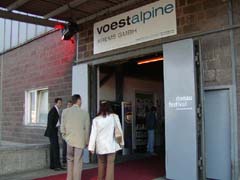 |
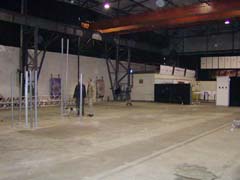 |
| Every single member of the Austrian staff was tall. We made previous arrangements with the Stage Manager, who looked to be twice the height of Mizushima. The sound and lighting technicians were also quite tall. Compared to the way most Japanese work, Austrians seemed to be more optimistic about getting their jobs done. So, we decided to go along with the European style, thinking that "waiting" was a part of our job; thus, we had coffee while we waited for them to finish the preliminary work.
Once the lighting was prepared and the stands were put up for us, it was our turn to take over. The Stringraphy Ensemble members moved unbelievably fast at stretching the strings. The instrument was set up while I looked on in blank amazement. It made me laugh to witness the sight of the small Japanese members working as if they were worker bees or ants. After spending two days on the preparations (run-trough, lighting and adjustment, sound testing and retesting, and then a dress rehearsal), it was finally time for our first-day concert. At the entrance, a table was prepared for the bar, and in the corner, a small, twenty-string Stringraphy was installed just for the audience to play as they wished. |
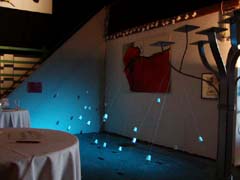
|
| The lights were turned down five minutes behind schedule.
The Stringraphy Ensemble members were already on the stage in the dark. The silk threads began to play the sounds of chirping birds as the light gradually became brighter. Then"Spring" by Vivaldi began to be heard. During our concerts in France, we mostly played our own original music pieces, so this was our first experience to play the classics, such as works by Vivaldi and Mozart. Our biggest concern about this tour was how the Austrian listeners, who are very familiar with classical music, would react to our performance. In response to thedirector's request, we included classical works and Japanese animation music in our program. Without hesitation, we selected "The Beautiful Blue Danube" as the last piece in the program, though we were all rather nervous about it. Th e "Stringraphy" was created by Mizushima only a little over ten years ago; thus, in comparison to instruments like the piano and violin, it still has to be improved upon before it is completed as an instrument. In Japan, many people do not approve of playing the classics on an incomplete instrument. |
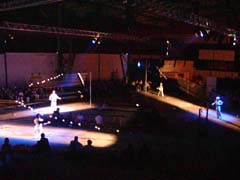 |
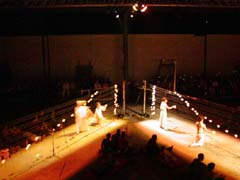 |
| However, as our concert proceeded, we knew that our worries were groundless, for we received thunderous applause from the audience. When the first half of the program was over, we took a short break to tune up. When we returned and began to play our original music, a hush fell over the audience, as the light shining on each player slowly brightened. The blue lights and the soft tones of silk threads slowly and pleasantly pervaded the space. The audience was taken into a strange but familiar world they had never experienced before. The soft tunes gradually became stronger and then harmonized as the music enveloped the entire venue, while also sublimating the atmosphere. The first original musical piece, "The Shadow of Wings", ended with its abrupt conclusion. At that instant, a storm of applause was heard from the audience. I felt as if the success of this concert was condensed into that loud applause. When the final piece, "The Beautiful Blue Danube", was played, most of the listeners had smiles on their faces. Even after we played in response to the second encore, the audience continued to cheer and clap enthusiastically. This Austrian concert was slightly different from the ones we held in France. It allowed all the Stringraphy Ensemble members to reconfirm the pleasure of artistic expression by permitting them to perceive the genuine warmth of an audience that truly loved music. |
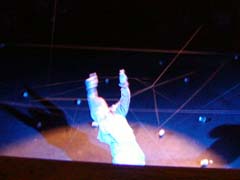 |
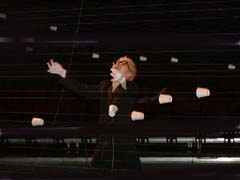 |
| Program (70min) | |
| Part 1. Mizushima's Arrangements |
|
| La Primavela | Antonio Vivaldi |
| Summer is icumen in | traditional |
| Bird List & Memorial | Michael Nyman |
| Mononoke Princess | Jo Hisaishi |
| Eine kleine Nachtmusik | W.A.Mozart |
| Sukiyaki song | Hachidai Nakamura |
| Part2. Original compositions from Kazue Mizushima |
|
| The Shadow of Wings | |
| Stringraphy Tapestry | |
| A Bird in a Cage | |
| The Air is full of sound | |
| A Phantom of Ancient Flute(Aerial Flute) | |
| Transformation of Etenraku | |
| Aerial Drum | |
| The Memory of Forest | |
| Solitude in June | |
| * |
|
| An der schonen blauen Donau Walzer | J. Strauss |
| Etude for Stringraphy | Kazue Mizushima |
| Red Dragon Fly | Kousaku Yamada |
| Kanon | Johann Pachelbel |
| HOME | KAZUE MIZUSHIMA | STRINGRAPHY | STUDIO EVE |